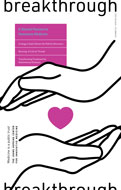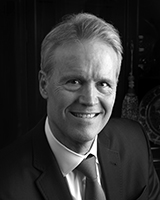

David B. Hellmann,
MD, MACP
As a high school physics student, I remember being gobsmacked by the idea of “escape velocity.” For those who haven’t cracked a physics textbook in a while, here’s a quick refresher: If you want to leave Earth to travel to the moon or to orbit our fine planet, you can’t do it by traveling at 500 mph, or 1,000 mph or even 10,000 mph. Escaping Earth’s gravitational pull requires reaching escape velocity — which scientists have measured to be a whopping 25,000 mph.
That’s indeed a dramatic acceleration. But then, breaking loose from Earth’s gravitational hold is itself a dramatic undertaking.
With this issue of Breakthrough, it struck me that escape velocity offers an apt metaphor for the transformational undertakings of CIM and its people. Consider the visionary work of Mary Catherine Beach and Scott Wright, who are bringing together standout clinicians from all across Johns Hopkins to build a community of scholars who are passionate about humanizing medicine. A recent addition to that community is the first nurse CIM scholar: Martha Abshire Saylor, whose research focuses on caregiver health. Martha’s arrival represents a crucial moment in CIM’s mission to humanize medicine, acknowledging that to achieve escape velocity, we can’t focus only on the doctor-patient relationship. As she notes: “Humanizing medicine is nursing. Enacting innovation in health care will only happen if nurses are engaged and in leadership positions — from conception to implementation”.
In the immunology lab, rheumatologist Max Konig is pursuing high-risk, high-reward research — applying gene therapy techniques that have worked so well in blood cancer to autoimmune disorders like lupus — that may very well revolutionize treatments for a host of autoimmune diseases. Max isn’t taking small, incremental steps in his scientific approach. He is thinking big to take giant leaps — to catch that escape velocity that will catapult patient care to new realms. In that quest, he is standing on the shoulders of Hopkins giants like urologist Patrick Walsh, whose innovations in nerve-sparing prostatectomy forever changed the course of prostate cancer care for men the world over.
I hope you enjoy reading about the compelling work of these and other CIM faculty members — including cardiologist Tom Traill, whose leadership is bringing fascinating new perspectives to our CIM Seminars — in the pages that follow. With your support, we can continue our ambitious efforts to catch the escape velocity that will allow us to shed the limitations of our contemporary health care system and catapult to a new orbit in patient care.

David B. Hellmann, M.D., M.A.C.P.
Aliki Perroti Professor of Medicine
Don Willett October 31st, 2023
Posted In:

David B. Hellmann,
MD, MACP
As a high school physics student, I remember being gobsmacked by the idea of “escape velocity.” For those who haven’t cracked a physics textbook in a while, here’s a quick refresher: If you want to leave Earth to travel to the moon or to orbit our fine planet, you can’t do it by traveling at 500 mph, or 1,000 mph or even 10,000 mph. Escaping Earth’s gravitational pull requires reaching escape velocity — which scientists have measured to be a whopping 25,000 mph.
That’s indeed a dramatic acceleration. But then, breaking loose from Earth’s gravitational hold is itself a dramatic undertaking.
With this issue of Breakthrough, it struck me that escape velocity offers an apt metaphor for the transformational undertakings of CIM and its people. Consider the visionary work of Mary Catherine Beach and Scott Wright, who are bringing together standout clinicians from all across Johns Hopkins to build a community of scholars who are passionate about humanizing medicine. A recent addition to that community is the first nurse CIM scholar: Martha Abshire Saylor, whose research focuses on caregiver health. Martha’s arrival represents a crucial moment in CIM’s mission to humanize medicine, acknowledging that to achieve escape velocity, we can’t focus only on the doctor-patient relationship. As she notes: “Humanizing medicine is nursing. Enacting innovation in health care will only happen if nurses are engaged and in leadership positions — from conception to implementation”.
In the immunology lab, rheumatologist Max Konig is pursuing high-risk, high-reward research — applying gene therapy techniques that have worked so well in blood cancer to autoimmune disorders like lupus — that may very well revolutionize treatments for a host of autoimmune diseases. Max isn’t taking small, incremental steps in his scientific approach. He is thinking big to take giant leaps — to catch that escape velocity that will catapult patient care to new realms. In that quest, he is standing on the shoulders of Hopkins giants like urologist Patrick Walsh, whose innovations in nerve-sparing prostatectomy forever changed the course of prostate cancer care for men the world over.
I hope you enjoy reading about the compelling work of these and other CIM faculty members — including cardiologist Tom Traill, whose leadership is bringing fascinating new perspectives to our CIM Seminars — in the pages that follow. With your support, we can continue our ambitious efforts to catch the escape velocity that will allow us to shed the limitations of our contemporary health care system and catapult to a new orbit in patient care.

David B. Hellmann, M.D., M.A.C.P.
Aliki Perroti Professor of Medicine
Don Willett October 31st, 2023
Posted In:

When Patrick Walsh arrived at Johns Hopkins 50 years ago as a young surgeon, prostate cancer often carried a death sentence. This was the era before prostate-specific antigen (PSA) blood testing, which today is widely used to screen for prostate cancer early on, when it is still treatable. Even patients who had potentially curable disease were rarely treated with curative intent, as radiation therapy had not yet sufficiently advanced. Surgery — the radical prostatectomy pioneered in the early 1900s by Johns Hopkins’ own Hugh Hampton Young — was widely considered worse than the disease itself.
That’s because 100% of men who underwent a radical prostatectomy became impotent, Walsh explains. Roughly 25% experienced severe urinary incontinence. Few surgeons even wanted to undertake the surgery because of the massive bleeding that occurred when operating.
In the early 1980s, Walsh forever changed the grim outlook for men the world over when he developed a surgical approach that became known as nerve-sparing radical prostatectomy. The technique allowed surgeons to excise the cancer while preserving a man’s potency and urinary continence. After completing the first purposeful such surgery on April 26, 1982, Walsh would go on to refine his technique while performing nerve-sparing surgeries on thousands of men at Johns Hopkins and beyond over the next three decades, even as he led Johns Hopkins’ Brady Urological Institute and edited the book known as the “bible” of urology, Campbell’s Urology. In 2012, it was renamed Campbell-Walsh Urology in his honor.
Now University Distinguished Service Professor of Urology Emeritus, Walsh recently spoke about his path of discovery in an inspiring CIM Seminar titled, “How Listening to a Patient Transformed the Care of Men with Prostate Cancer.” As Walsh tells it, his breakthrough discovery hinged on a series of seeming coincidences — which he, as a man of deep Christian faith, attributes to divine providence. While it’s impossible to capture the full scope of Walsh’s talk in the short space available, a few highlights stand out.
In the early 1980s, Walsh forever changed the grim outlook for men the world over when he developed a surgical approach that became known as nerve-sparing radical prostatectomy.
Key Moments in Patrick Walsh’s Path to Discovery
I listened to my patient when he told me following surgery that he was sexually potent — and I wondered why.
Intent on improving the “problem with bleeding” in prostate surgery during the late 1970s and early 1980s, Walsh zeroed in on the anatomy of the veins surrounding the prostate by using the operating room as his anatomy lab. At this point, he explains, the veins that caused the bleeding had never been charted, the location of the nerves responsible for erection was unknown and the muscles for urinary control were incorrectly identified.
Walsh was able to identify a common trunk of veins over the urethra. This led to a technique that reduced blood loss dramatically, providing a safer and more thorough prostate cancer operation. Soon after using this technique, Walsh says, a patient returning for follow-up from prostate cancer surgery announced that he was fully potent.
How could that be? “At that time, everyone believed that the nerves that controlled erectile function ran through the prostate, and it would be impossible to preserve potency,” he recalls. “But from this one patient, I knew that this was not true. But where were the nerves? The answer was not available in any textbook.”
I invited an older, lonely-looking man who was a total stranger to dinner — and I met with that “lonely stranger” four years later and 4,000 miles away in Leiden, the Netherlands.
Within weeks of that momentous patient encounter, Walsh attended an international urological conference with his wife. At dinner one night, he noticed an older man about to be seated alone. “For the first and only time in my life, I went up to a total stranger and asked if he would like to join us for dinner, and I asked why he was in town,” Walsh recalls.
The man was Pieter Donker, chair of urology at the University of Leiden in the Netherlands, and the trio had a wonderful dinner together. Four years passed — a time during which Walsh continued to investigate the nerve mystery evoked by his potent patient. Donker was retired at this point, but his successor invited Walsh to attend a surgical congress in Leiden. On the last day, Walsh’s 43rd birthday, “My host told me that Dr. Donker appreciated my kindness a few years earlier and wanted to return the favor by taking me to see the windmill museum in Leiden.”
When the two met up, Donker mentioned that in retirement, he was working in an anatomy lab. Walsh suggested they abandon the museum tour and go to the lab instead, where Donker was dissecting nerves to the bladder in a stillborn baby. Once there, “when I asked about the location of the nerves responsible for erections,” says Walsh, “he said he had never looked.” The two got to work. “Three hours later, there they were, outside the prostate.”
Returning to Johns Hopkins, Walsh in 1981 found that there were vessels located in the exact site where the nerves were present in the fetal dissections. “I speculated that these vessels might provide the scaffolding for these microscopic nerves and could be used as the macroscopic landmark to identify them in the operating room,” he explains. Using that technique, Walsh performed that first nerve-sparing radical prostatectomy on a 52-year-old man in April 1982. The patient would go on to live a normal life, cancer-free.
Over the next decade, radical prostatectomy became the most common form of treatment for localized prostate cancer in the United States.
I continued to listen to my patients.
Between 1982 and January 2011, when Walsh performed his last surgery, he completed nerve-sparing prostatectomies on 4,569 patients. “I spoke to every one of those patients every three months in the first year after their surgeries — that was more than 18,000 telephone conversations,” he says. Those conversations were crucial in guiding him to further refine his surgical technique and improve quality of life measures, Walsh says. “I made 28 changes over those 29 years.”
At the time Walsh stopped operating, 93% of his patients who underwent nerve-sparing prostatectomies reported being potent at 18-month follow-up. And 95% had total urinary control.
At the time Walsh stopped operating, 93% of his patients who underwent nerve-sparing prostatectomies reported being potent at 18-month follow-up. And 95% had total urinary control.
“These results were far, far different from when I began my journey,” he says.
For CIM Director David Hellmann, Walsh’s careerlong, patient-centered approach to discovery and patient care provides a perfect case study for the importance of humanizing medicine.
Says Hellmann: “It illuminates that listening to patients is important not only because patients value it and it rejuvenates physicians and nurses, but when coupled with clinical excellence and deep scientific curiosity, listening to patients can drive dramatic discoveries and innovation — and change the way medicine is practiced for the better. That is exactly what Dr. Walsh has done.”
Don Willett October 31st, 2023
Posted In:

Launched in 2018 by CIM’s Miller Coulson Academy of Clinical Excellence to bring today’s doctors “closer to Osler” — with essays, articles and poetry that stimulate reflection about providing exceptional care to patients — the CLOSLER site has made its mark among clinicians the world over.
“The success of CLOSLER has exceeded my wildest expectations,” says Scott Wright, director of the Miller Coulson Academy. “We now have articles coming in from far and wide — from students, medical residents, faculty members, nurses, pharmacists and more. They share brilliant insights and moving stories about communicating more effectively with patients and providing truly humanistic care. And we have gained a huge following from around the globe.”
“We’ve been consistent in publishing a new piece every day, Monday through Friday. That’s a lot in five years!” adds managing editor Gretchen Miller.
“We now have articles coming in from far and wide — from students, medical residents, faculty members, nurses, pharmacists and more. They share brilliant insights and moving stories about communicating more effectively with patients and providing truly humanistic care.” – Scott Wright
Last year, in response to growing interest in the humanities in medicine, CLOSLER launched a new forum for “creative arts in medicine.” In one recent entry, a young doctor focused on countering burnout through music, offering a lamplit performance on a seven-stringed Indian classical musical instrument. In another, a medical student from Johns Hopkins shared her passion for pottery and discussed how it allows her to connect more deeply with her work.
Most recently, CLOSLER added a podcast to its mix: The Making of a Clinician, the brainchild of three premed students who are serving as CLOSLER interns, which has explored themes such as LGBTQ voices in medicine and White Coats for Black Lives.
“It’s really been a joy to see CLOSLER expand and evolve,” says Wright. “The site has made the Hopkins name synonymous with clinical excellence. CLOSLER is showing that this is where the ‘magic’ happens.”
To read more, visit: closler.org
Don Willett October 31st, 2023
Posted In:

On a picture-perfect early September afternoon, against a backdrop of rolling cornfields, dozens of Johns Hopkins’ most compassionate health care professionals gathered outdoors at Folly Farms, the Baltimore County home of Stephanie Cooper Greenberg, chair of CIM’s International Advisory Board, and husband, Erwin, for the annual CIM retreat.
Their first order of business? To answer this prompt: Humanizing medicine is important to me because…
One by one, doctors and other clinicians from a wide variety of disciplines and perspectives took the mic and shared personal — and very moving — responses. A sampling:
“Because I truly believe that in order to heal someone, we have to know them.”
“Because I see how enthusiastic and bright medical students are when they enter medicine, and I want to make sure that doesn’t burn out.”
“Because I believe it’s the foundation of solving health inequities. It’s the thing that can cut through all of the noise and remind us of who we are serving and who they are loved by.”
“Because contrary to popular belief, technical expertise is absolutely not enough if we want to provide great care, or even good care, for our patients and communities.”
“Because the training environment has become patient-proximate and not patient-centered. The road back goes through connecting with our patients, and connecting with each other, at the bedside.”
For internists Mary Catherine Beach and Scott Wright, who planned the retreat and are key leaders of CIM’s new Initiative for Humanizing Medicine (IHM), the heartfelt insights were welcome evidence that the IHM is an idea whose time has definitely come.
“To listen to everyone enthusiastically provide their reasons for why humanizing medicine was important to them, and to have those responses be so different and personal … That was a turning point for me, to go from, ‘I think this is a good idea’ to, ‘Wow, this is going to be a reality!’” says Beach, who is a co-director of the IHM and a Mary and David Gallo CIM Scholar.
“There is a real risk that the importance of knowing the patient as a person will be determined as something with low return on investment — and it will be lost from medicine entirely. If that happens, it would be a deep and grievous loss.” – Cynthia Rand
Says Wright, who is director of CIM’s Miller Coulson Academy of Clinical Excellence and the Anne G. and G. Thomas Miller Professor of Medicine: “To a person — and there was great diversity in terms of where they work and what they do — each attendee asserted that humanizing medicine is at the core of medicine and is truly important to them. What’s more, they want to be working with colleagues who have this as priority A1.” He adds, “Hearing and seeing the passion people feel about this was exciting and invigorating — and it gives us confidence that this is going to be a great initiative.”
Cynthia Rand, Mary and David Gallo CIM Scholar and IHM senior adviser, struck a serious note when she rose to elaborate on her own response to the prompt. “We are at a tipping point with the commoditization of health care,” she said. “There is a real risk that the importance of knowing the patient as a person will be determined as something with low return on investment — and it will be lost from medicine entirely. If that happens,” she said, “it would be a deep and grievous loss.”
A Scholarly Community
Of course, Rand, Wright and Beach are all optimistic that such a loss will be averted at Johns Hopkins because of the groundswell of support for clinical excellence among Johns Hopkins physicians, nurses and other clinicians.
Wright, who was instrumental in the launch of the Miller Coulson Academy in 2008, has seen it grow to now include more than 100 members (see listing on p. 20 with fall 2023 inductees). The Miller Coulson Academy broke new ground by demonstrating that clinical excellence could be measured in a clear and consistent way. By developing a truly rigorous process for measuring excellence in clinical care, CIM really made a mark — at Johns Hopkins and on the national level, Wright notes. One prime example: the recent establishment of a new promotion track at Johns Hopkins Medicine for faculty members who excel at patient care.
“The Miller Coulson Academy has been laying the groundwork for clinical excellence over the last 10 to 15 years. With all we have learned, this will really help us as we build — and dream about — what this Initiative for Humanizing Medicine can be.” – Scott Wright
The Miller Coulson Academy has been laying the groundwork for clinical excellence over the last 10 to 15 years,” says Wright, a Mary and David Gallo CIM Scholar. “With all we have learned, this will really help us as we build — and dream about — what this Initiative for Humanizing Medicine can be.”
Moving forward, Beach says, the mission will be “to create and support an intellectual scholarly community,” through which those who attended the retreat — and others at Johns Hopkins who are committed to humanizing medicine — can find like-minded collaborators for research and education projects aimed at advancing truly patient- and family-centered care.
Wright notes that just as the Miller Coulson Academy was successful in bringing people together to do things they couldn’t do by themselves, such as CLOSLER.ORG, so will the Initiative for Humanizing Medicine succeed in uniting clinicians with shared missions who might not otherwise have ever met or worked together.
“We know that bringing people together in teams results in greater creativity,” he says. “We’re hoping for some wonderfully spontaneous collaborations.”
Building a Pipeline
In addition to expanding opportunities for networking and collaboration, Beach is excited about cultivating the pool of mentors for a rapidly growing group of medical school students, trainees and early-career faculty members who are passionate about pursuing projects that are focused on humanizing medicine.
Beach herself is already mentoring a notable number of mentees and mentee teams. Just a few examples:
And that’s just the tip of the iceberg, says Beach, adding, “I love working with all of these passionate, committed physicians and students, and we’ve got so many projects going across many different disciplines: public health, medicine, engineering, the Armstrong Institute for Patient Safety and Quality…”
Importantly, she notes that seed funding provided by the IHM has already enabled many of her mentees to conduct the early research needed to attract much larger grants from the National Institutes of Health (NIH) and other external funders.
The pilot data that Boss collected, for example, laid the foundation for a recent NIH RO1 grant award of $3.2 million, as well as $425,000 in separate NIH funding. All told, Beach and those she mentors have garnered nearly $8 million in external funding just in the past few years to advance research central to humanizing medicine.
“By supporting medical students and other early-career trainees with funding to conduct projects they are really excited about, we are building a pipeline of young researchers who will go on to do big things in humanizing medicine. This does a lot of good downstream.” – Mary Catherine Beach
“There is another beautiful thing about these small grants awarded through CIM,” says Beach. “By supporting medical students and other early-career trainees with funding to conduct projects they are really excited about, we are building a pipeline of young researchers who will go on to do big things in humanizing medicine. This does a lot of good downstream.”
Don Willett October 31st, 2023
Posted In: